 |
Convert H263 to MOV/QuickTime
|
H263 to MOV Converter Software converts H263 files to MOV
with H.264 or MPEG-4 video codecs. The MOV is QuickTime File Format (QTFF) used
natively by the QuickTime application. The MOV is very common on Mac OS like WMV
on Windows. It's a great tool for converting format when transferring file to
Mac OS. The H263 to MOV Converter Software also supports other video, audio,
and device formats, for example, FLV, iPad, MMF, AC3, H.264, AVI, AIFF, etc.
The software could convert M4V to FLAC, MPEG to CAF (Core Audio Format), RM to H.264, MP4 to PPM image sequence, AVI to iPhone,
and so on.
H263 to MOV Converter Software supports batch conversion and, is compatible
with Windows 10/8/7/Vista/XP/2000 (both x86 and 64-bit platforms).

What is H263?
H.263 is a video codec standard originally designed as a low-bitrate compressed
format for videoconferencing. The coding algorithm of H.263 is similar
to that used by H.261, however with some improvements and changes to improve
performance and error recovery. H.263 is a hybrid of interframe compression
and intraframe transform coding. H.263 is CPU intensive, so data rates
higher than 50 KBps may bog down most machines. It may not play well on
lower-end machines. Its first version was completed in 1995 and provided
a suitable replacement for H.261 at all bitrates. It was initially made
to serve H.324 based low-bitrate internet communication systems (videoconferencing
and telephony), but as new extensions were added to the further versions,
H.263 found use in other applications. As H.264 provides a significant
improvement in capability beyond H.263, the H.263 standard is now considered
a legacy design. H.263 supports international transmission systems, telephone
circuits, telegraphy, facsimile and leased circuits H.263v2 (also known
as H.263+, or as the 1998 version of H.263) is the informal name of the
second edition of the ITU-T H.263 international video coding standard.
It retained the entire technical content of the original version of the
standard, but enhanced H.263 capabilities by adding several annexes which
can substantially improve encoding efficiency and provide other capabilities
(such as enhanced robustness against data loss in the transmission channel).
The H.263+ project was ratified by the ITU in February 1998. Some parts
of the hierarchical structure of the datastream are now optional, so the
codec can be configured for a lower datarate or better error recovery.
What is MOV?
MOV is a file extension used by the QuickTime-wrapped files. The format
was created by Apple Computer to work with multimedia files. If you're
emailing a clip or simply need more storage space, set the preferences
for files that use the MOV extension to make the most efficient use of
your storage space. Other file formats that QuickTime supports natively
(to varying degrees) include AIFF, WAV, DV-DIF, MP3, and MPEG program stream.
Each track either contains a digitally encoded media stream (using a specific
format) or a data reference to the media stream located in another file.
Because both MOV and MP4 containers can use the same MPEG-4 codecs, they
are mostly interchangeable in a QuickTime-only environment. MP4, being
an international standard, has more support. This is especially true on
hardware devices, such as the Sony PSP and various DVD players; on the
software side, most DirectShow / Video for Windows codec packs include
an MP4 parser, but not one for MOV. The classic version of QuickTime is
available for Windows XP and later, as well as Mac OS X Leopard and later
operating systems. Using a Quicktime player that either comes with a Web
browser or can be downloaded from Apple or the browser company, you can
view and control brief multimedia sequences. MOV video file is common multimedia
format often used for saving movies and other video files, uses a proprietary
compression algorithm developed by Apple Computer, compatible with both
Macintosh and Windows platforms.The format specifies a multimedia container
file that contains one or more tracks, each of which stores a particular
type of data: audio, video, effects, or text (e.g. for subtitles).
How to Convert H263 to MOV/QuickTime?
- Free Download H263 to MOV Converter
Software
- Install the Program by Step-by-step Instructions
- Launch H263 to MOV Software
- Choose H263 Files

Click "Add Files" to choose H263 files.

Choose one or more H263 files you want to convert and then click Open.
H263 to MOV Software will open H263 files and get file information
of the file such as width, height, frame rate, video bit rate, audio sample rate,
audio bit rate, audio channels, and then display the information of H263 file
at conversion list.
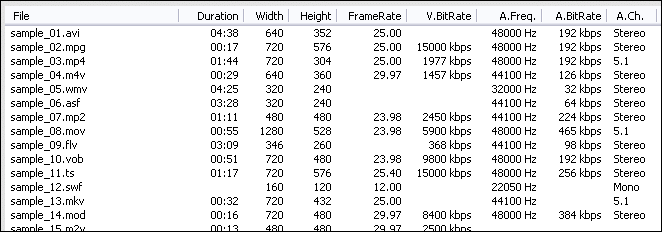
- Choose Output Format
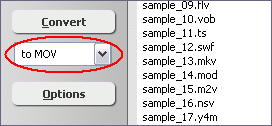
Click on combo box of output format and then choose "to MOV".
- [Optional, for advanced user]
Set MOV Encoding Parameters
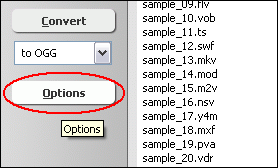
If you want to change MOV encoding parameters such as video codec, bit rate,
frame rate, video size, aspect ratio, audio codec, and so on, please click "Options".
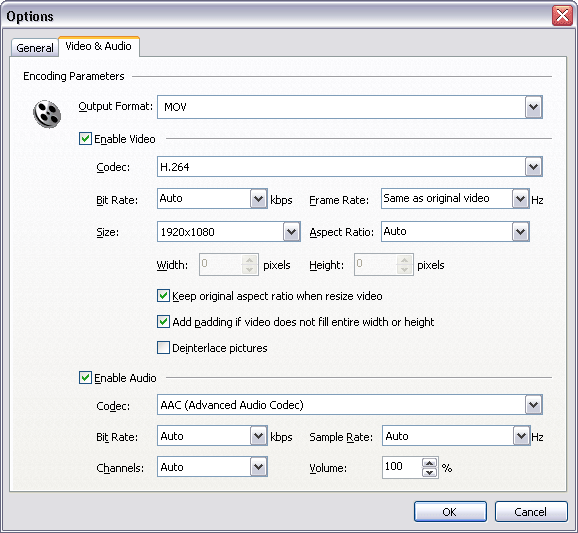
And then, switch to tab "Video & Audio" and choose "MOV"
at "Output Format", and then set options for video and audio
encoding.
You could choose H.264 or MPEG-4 for video codec. The audio codec is AAC only.
- Convert H263 to MOV
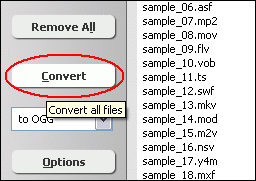
Click "Convert" to convert all H263 files in list to MOV format.

The software is converting H263 files to MOV.
- Play and Browse MOV File
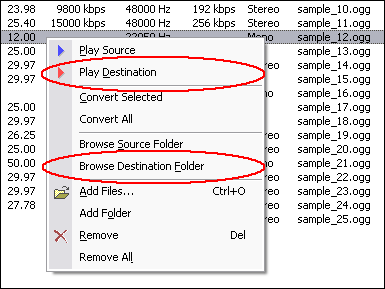
When conversion completes, you can right-click converted item and choose "Play
Destination" to play the outputted MOV file; or choose "Browse Destination
Folder" to open Windows Explorer to browse the outputted MOV file.
- Done
Top
H263 to MOV Software is 100% clean and safe to
install. It's certified by major download sites.

Convert H263 to MOV/QuickTime Related Topics:
|











